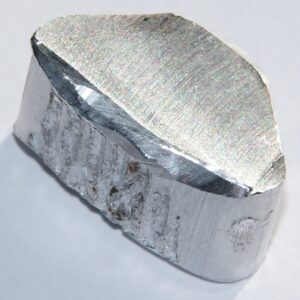When most people hear aluminum they think of soda cans or aluminum foil, but what about jewelry? Due to rising costs and availability of materials, I’ve turned to aluminum as a source of metal for jewelry making. I’m not the first and certainly won’t be the last to use aluminum in jewelry, but it’s still relatively rare, especially amongst artisan and fine jewelers.

There are a few reasons I’m choosing to experiment with this versatile metal:
- Mimics the color of silver without the price tag
- Hypoallergenic, perfect for those with metal allergies.
- Soft enough to work with to bend into shape but not too soft for wearing
- Absolutely fantastic for embossing, chase and repousse. It doesn’t require constant annealing.
- NEVER tarnishes or corrodes so it’s very little upkeep.
- Very light allowing me to make larger pieces.
- Aluminum can’t be soldered so I don’t have to worry about the cost of gas for my aluminum projects. I can join two pieces together with creative rivets!
Most artisan and fine jewelers refuse to work with aluminum because it can contaminate silver when soldering it. The aluminum can mix with flux or solder and cause the silver solder not to flow. But a little studio practice change and jewelers can keep aluminum separate from their other metals with no issue. I work on all my aluminum projects all at once and when I’m done I do a thorough cleaning of my bench and tools.
But what is aluminum? Where does it come from? Let’s explore below!

History of Aluminum
Aluminum or aluminium is a metal that is very rare in its “native” or pure form. The aluminum that we’re familiar with must be extracted from a certain sedimentary rock called bauxite, found mostly in China and Australia. Because of this process aluminum was widely unknown for most of human history until the 1800s. The compound “alum” however, has been known since the 5th century BCE and used for dyeing up to the Middle Ages.
Aluminum was discovered in 1825 by Danish Physicist Hans Christian Orsted. This metal was difficult to refine and therefore upon its discovery it was more valuable than gold. However, French chemist Henri Etienne Saine-Claire Deville reduced the price of aluminum after his first industrial production using a chemical process of refining the ore. This led to James Fern Webster in 1878 producing 100 pounds of pure aluminum every week using this same chemical method. He later founded Webster’s Patent Aluminum Crown Metal Company Ltd in 1884. This method of mass production led to aluminum being the most produced non-ferrous metal (any metal that is not iron or steel), surpassing copper. Aluminum is now used in engineering, construction, aviation, packaging and the list goes on. Production of this versatile metal today exceeds those of all non-ferrous metals combined.

Aluminum in Jewelry
After 1930, European countries, such as France and Italy, started producing aluminum coins and utensils, making it more readily available as a material for jewelry. The African market took advantage of this versatile metal in their jewelry and the era of Aluminum African jewelry was born. Aluminum is favorable to jewelers and craftspersons because it’s light, allowing larger pieces, soft, flexible, and completely free of corrosion or tarnish. Aluminum is very similar in appearance to silver, but far less expensive. For this reason it is called “poorman’s silver”. It’s also easy to melt down compared to its non-ferrous counterparts. Aluminum’s melting point is 1220 degrees Fahrenheit vs Silver at 1763 degrees Fahrenheit. Another advantage to Aluminum is that it can be indefinitely recycled, melted down over and over again, never losing its integrity, making it one of the most sustainable metals on Earth. It’s important to note however, the extraction of aluminum is very labor and energy intensive just like any kind of ore extraction. But we can take solace in the fact that over 80% of Aluminum ever mined is still in circulation.
I’m still in the experimental phase of using aluminum in my own jewelry but one thing I know for sure, I LOVE aluminum and I hope my customers will come to love it too!


